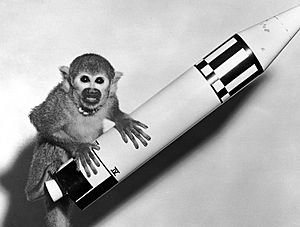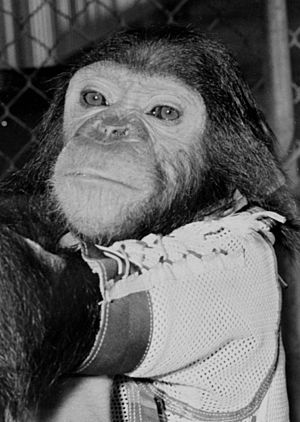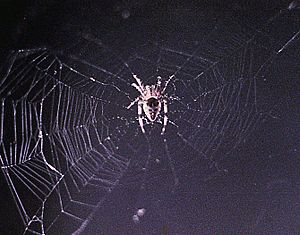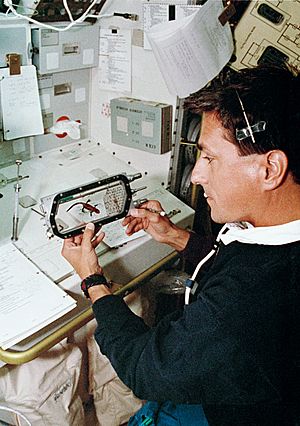Animals in space facts for kids

Animals in space were first sent to see if living things could survive spaceflight. This happened before human spaceflights were tried. Later, other animals were flown to study how microgravity (weightlessness) and space travel affected their bodies.
The study of life in space is called Bioastronautics. So far, seven countries have sent animals into space: the United States, Soviet Union (now Russia), France, Argentina, China, Japan, and Iran.
Many different animals have traveled to space. These include monkeys and apes, dogs, cats, tortoises, mice, rats, rabbits, fish, frogs, spiders, and even insects. Some quail eggs even hatched in space in 1990 on the Mir space station!
The U.S. launched the first Earthlings into space. These were fruit flies in 1947. They also flew primates (monkeys and apes) mainly between 1949 and 1961. France sent monkeys in 1967. The Soviet Union and Russia launched monkeys from 1983 to 1996. In the 1950s and 1960s, the Soviet space program used many dogs for short trips and longer orbital flights.
In 1968, two tortoises and several plants were the first Earth creatures to go around the Moon. This happened on the Zond 5 mission. In 1972, five mice named Fe, Fi, Fo, Fum, and Phooey orbited the Moon 75 times. They were on Apollo 17's Command Module America, which was the last human trip to the Moon.
Why Animals Went to Space
Animals have been used in air travel experiments since 1783. That year, the Montgolfier brothers sent a sheep, a duck, and a rooster up in a hot air balloon. They wanted to see if animals that live on the ground could survive high up.
Later, the U.S. used captured German V-2 rockets. They also used high-altitude balloons. These carried fruit flies, mice, hamsters, guinea pigs, cats, dogs, frogs, goldfish, and monkeys. They went up to 44,000 meters (about 27 miles). These flights from 1947 to 1960 tested how much radiation exposure animals could handle. They also checked how their bodies reacted and if life support systems worked.
Space Animal Timeline

1940s: The First Journeys
The very first animals sent into space were fruit flies. They were launched by the U.S. on a V-2 rocket on February 20, 1947. The rocket took off from New Mexico. The goal was to see how radiation at high altitudes affected them. The rocket went 109 kilometers (68 miles) high. This is past the official boundary of space. The fruit flies were recovered alive.
Albert II, a rhesus monkey, became the first monkey, first primate, and first mammal in space. This happened on June 14, 1949, also on a U.S. V-2 rocket. Albert II reached about 134 kilometers (83 miles) high. Sadly, he died when his parachute failed during landing. Many monkeys were flown by the U.S. in the 1950s and 1960s. They had sensors to check their body signs. Many monkeys did not survive these early missions.
1950s: Dogs, Monkeys, and Orbit
On August 31, 1950, the U.S. sent a mouse into space (137 km or 85 miles). The mouse died because its parachute failed.
On July 22, 1951, the Soviet Union launched the dogs Tsygan ("Gypsy") and Dezik. They went into space but did not orbit Earth. These two dogs were the first living creatures to successfully return from a spaceflight. Both survived, though Dezik later died on another flight.
On November 3, 1957, the Soviet Sputnik 2 spacecraft carried the first animal into orbit. This was the dog Laika. Laika died during the flight. This was expected because the technology to bring spacecraft back from orbit had not yet been invented. Many other dogs were launched before Yuri Gagarin became the first human in space in 1961.
On December 13, 1958, a U.S. rocket carried a squirrel monkey named Gordo. His parachute failed, and Gordo was lost. But data showed he survived the launch and weightlessness.
Monkeys Miss Able and Miss Baker became the first monkeys to survive spaceflight. This happened on May 28, 1959. They rode in a missile to an altitude of 579 kilometers (360 miles). They survived the flight well. Able died a few days later from a reaction to medicine. Baker lived until 1984.
On July 2, 1959, a Soviet rocket carried two dogs and Marfusha, the first rabbit in space.
1960s: Chimps and Cats

On August 19, 1960, the Soviet Union launched Sputnik 5. It carried the dogs Belka and Strelka, a rabbit, mice, rats, fruit flies, and plants. This was the first spacecraft to carry animals into orbit and bring them back alive.
On January 31, 1961, Ham, a chimpanzee, was launched into space. He became the first great ape in space. Ham was trained to pull levers for banana pellets. His flight showed that tasks could be done in space.
Enos became the first chimpanzee to orbit Earth. He flew two orbits on November 29, 1961.
On March 9, 1961, the Soviet Union launched a dog named Chernushka, mice, frogs, and the first guinea pig into space. All were recovered safely.
France flew their first rat (Hector) into space on February 22, 1961.
On October 18, 1963, France launched Félicette the cat. She had sensors in her brain to record signals. Félicette was recovered alive after a 15-minute flight. Scientists studied her brain signals. A statue of Félicette was put up in France in 2019.
China launched mice and rats in 1964 and 1965, and two dogs in 1966.
On February 22, 1966, two Soviet dogs, Veterok and Ugolyok, spent 22 days in orbit. This was the longest space flight by dogs.
The U.S. launched Biosatellite missions with fruit flies, wasps, beetles, and frog eggs.
On September 14, 1968, the Soviet Union sent the first animals to circle the Moon. These were two tortoises on Zond 5. They traveled around the Moon with wine flies and meal worms. They survived but lost some weight.
1970s: Frogs, Fish, and Spiders

On November 9, 1970, two bullfrogs were launched to study space motion sickness.
Apollo 17, launched on December 7, 1972, carried five pocket mice. They stayed in the command module as it circled the Moon.
Skylab 3 (1973) carried pocket mice, the first fish in space (a mummichog), and the first spiders in space (Arabella and Anita).
The Soviets flew several Bion missions with tortoises, rats, and mummichog. On Soyuz 20 (1975), tortoises set a record by spending 90.5 days in space.
1980s: Newts and Chicken Eggs
The Soviet Union sent eight monkeys into space in the 1980s. These Bion flights also carried zebra danio fish, fruit flies, rats, and the first newts in space.
In 1985, the U.S. sent two squirrel monkeys and 24 rats on the Space Shuttle.
On Bion 7 (1985), 10 newts had parts of their front limbs removed. This was to study how fast they could regrow in space. This knowledge helps understand how humans might recover from injuries in space.
After an experiment was lost in the Space Shuttle Challenger disaster, chicken embryos (fertilized eggs) were sent into space in 1989. This was for a student contest.
1990s: More Diverse Animals
Four monkeys flew on the last Soviet Bion flights, along with frogs and fruit flies. Other flights carried dormant brine shrimp, newts, fruit flies, and sand desert beetles.
China launched guinea pigs in 1990.
A Japanese journalist carried Japanese tree frogs to the Mir space station in 1990. Other experiments on Mir involved quail eggs.
Japan launched its first animals, a type of newt, in 1995.
In the 1990s, the U.S. carried many animals on Space Shuttles. These included crickets, mice, rats, frogs, newts, fruit flies, snails, carp, medaka (rice fish), oyster toadfish, sea urchins, swordtail fish, and jellyfish.
2000s: Spiders, Ants, and Cockroaches
The last flight of Columbia in 2003 carried silkworms, garden orb spiders, carpenter bees, harvester ants, and Japanese killifish (medaka). Even after the Space Shuttle Columbia disaster, some nematodes (tiny worms) were found alive in the debris.
These tiny worms are also part of experiments on the International Space Station.
Some early Space Shuttle missions included projects from school students. These often involved ants, stick insect eggs, and brine shrimp cysts.
In 2006, Bigelow Aerospace launched their Genesis I module. It carried insects like Madagascar hissing cockroaches and Mexican jumping beans (which contain moth larvae). This might have been the first private flight to send animals into space. Genesis II in 2007 also carried cockroaches, scorpions, and seed-harvester ants.
In September 2007, tiny creatures called tardigrades (water-bears) survived 10 days in open space.
On the same mission, cockroaches were carried in a sealed container. One female cockroach, Nadezhda, became the first Earth creature to have babies that were conceived in space.
In 2009, a free-tailed bat was seen clinging to the Space Shuttle's fuel tank during launch. It likely died during the climb to orbit.
Also in November 2009, painted lady and monarch butterfly larvae went to space for a school experiment. Thousands of tiny worms (C. elegans) went for studies on weight loss.
2010s: Squid, Geckos, and Mice
In May 2011, the last flight of the Space Shuttle Columbia carried two golden orb spiders, Gladys and Esmeralda. They also had a fruit fly colony for food. This was to study how weightlessness affected spider behavior.
In October 2012, 32 medaka fish were sent to the International Space Station for a new Aquatic Habitat.
In January 2013, Iran reported sending a monkey into space and bringing it back. In February 2013, Iran also launched a mouse, two turtles, and some worms, which returned alive.
In January 2014, scientists studied the search methods of pavement ants on the ISS.
In July 2014, Russia launched geckos to study how weightlessness affected reptile reproduction. All five geckos died, likely from freezing.
In September 2014, 20 mice were sent to the ISS to study the long-term effects of weightlessness on rodents.
In April 2015, another 20 mice went to the ISS. This was to study muscle and bone loss in space. Scientists hope this helps understand muscle loss in people who cannot be active.
In April 2016, 20 more mice were sent to study how to prevent muscle and bone loss.
In June 2018, 20 mice went to the ISS for a record-breaking journey. This study looked at how being in space affected their bodies and sleep.
The Chinese lunar lander Chang'e 4 carried seeds and insect eggs. This experiment tested if plants and insects could grow together on the Moon. It included cottonseed, potato, rapeseed, a flowering plant, yeast, and fruit fly eggs.
2020s: Water Bears and Squid
On June 3, 2021, SpaceX CRS-22 launched tardigrades (water bears) and Hawaiian bobtail squid to the ISS. The squid were launched as babies. Scientists will study if they can get their special glowing bacteria while in space.
See also
 In Spanish: Animales en el espacio para niños
In Spanish: Animales en el espacio para niños
- Alice King Chatham – American designer who designed equipment for some of the first animals in space
- Bioastronautics
- Félicette, first, and only, cat in space
- Félix I, a cancelled Brazilian Army project to launch a cat in 1958-59.
- List of microorganisms tested in outer space
- Model organism
- Monkeys and apes in space
- One Small Step: The Story of the Space Chimps, 2008 documentary
- Plants in space
- Soviet space dogs
- Space Dogs, 2010 film


